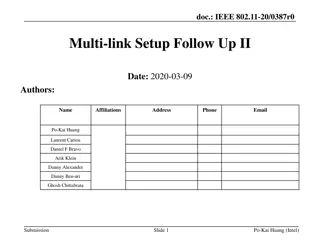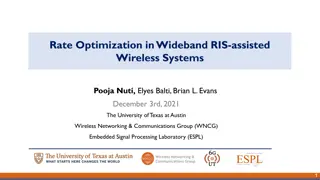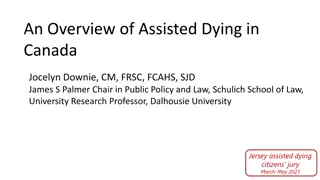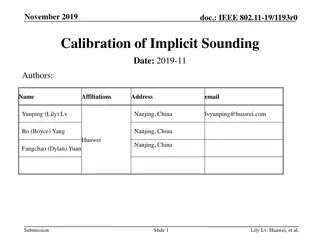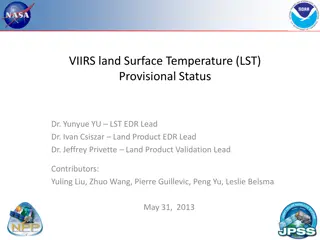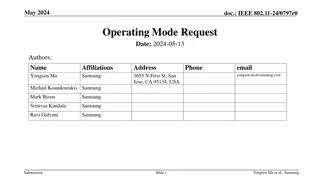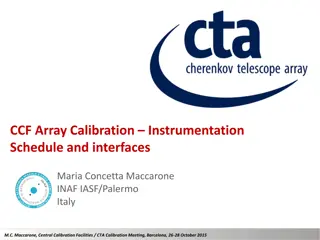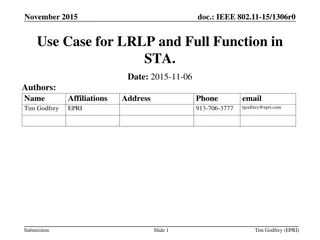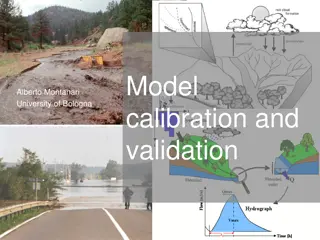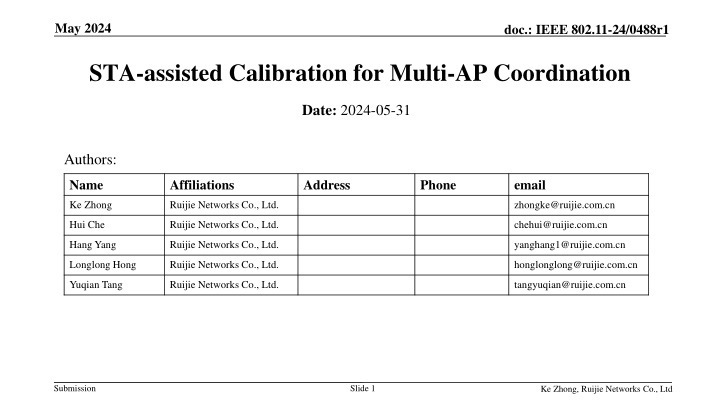
STA-Assisted Calibration for Multi-AP Coordination in IEEE 802.11-24
Explore a method of STA-assisted calibration for multi-AP coordination in the context of IEEE 802.11-24. This approach addresses synchronization challenges and aims to enhance the performance of multi-AP deployments, especially in scenarios with non-ideal synchronization and backhaul conditions. By leveraging STA feedback and assistance, this calibration method proposes to improve the alignment of scheduling, sharing, and precoding among APs, facilitating more effective multi-AP operation for enhanced reliability, spectral efficiency, and reduced latency.
Download Presentation

Please find below an Image/Link to download the presentation.
The content on the website is provided AS IS for your information and personal use only. It may not be sold, licensed, or shared on other websites without obtaining consent from the author. If you encounter any issues during the download, it is possible that the publisher has removed the file from their server.
You are allowed to download the files provided on this website for personal or commercial use, subject to the condition that they are used lawfully. All files are the property of their respective owners.
The content on the website is provided AS IS for your information and personal use only. It may not be sold, licensed, or shared on other websites without obtaining consent from the author.
E N D
Presentation Transcript
May 2024 doc.: IEEE 802.11-24/0488r1 STA-assisted Calibration for Multi-AP Coordination Date: 2024-05-31 Authors: Name Affiliations Address Phone email Ke Zhong Ruijie Networks Co., Ltd. zhongke@ruijie.com.cn Hui Che Ruijie Networks Co., Ltd. chehui@ruijie.com.cn Hang Yang Ruijie Networks Co., Ltd. yanghang1@ruijie.com.cn Longlong Hong Ruijie Networks Co., Ltd. honglonglong@ruijie.com.cn Yuqian Tang Ruijie Networks Co., Ltd. tangyuqian@ruijie.com.cn Submission Slide 1 Ke Zhong, Ruijie Networks Co., Ltd
May 2024 doc.: IEEE 802.11-24/0488r1 Abstract Introduction Calibration issue for Multi-AP coordination STA-assisted Calibration for Multi-AP Coordination Conclusion Submission Slide 2 Ke Zhong, Ruijie Networks Co., Ltd
May 2024 doc.: IEEE 802.11-24/0488r1 Introduction In PAR of P802.11bn, the Ultra High Reliability (UHR) capability has been defined to improve Rate-vs- Range enhancement, reduce latency, and reduce power consumption for AP, compared to Extremely High Throughput (EHT) MAC/PHY operation. Multi-AP operation (aka. Multi-AP coordination/transmission) has been proposed as one of the key candidate features to meet the requirement of UHR capability, balancing the quality of service for STAs at all the coverage areas of a system. Both the spectral efficiency and robustness can be improved with multi-AP operation. Especially in higher frequency bands, multi-AP operation is helpful and necessary in overcoming blocking effects, ensuring transmission/reception reliability and reducing latency. However, it is difficult to truly achieve the performance gain of multi-AP operation without compensating non-ideal factors, such as calibration error among coordination APs, in actual deployment conditions. In this contribution, we propose a method of STA-assisted calibration for multi-AP coordination. Submission Slide 3 Ke Zhong, Ruijie Networks Co., Ltd
May 2024 doc.: IEEE 802.11-24/0488r1 Calibration issue for Multi-AP coordination Synchronization is essential for multi-AP coordination schemes, especially for joint transmission (JT). For JT, there are non-coherent JT (NC-JT) and coherent JT (CJT). CJT can improve coverage and average throughput in commercial deployments assuming ideal or high-performance backhaul and synchronization, expanding the utility of multi-AP deployments. However, assuming ideal backhaul and synchronization among APs are not practical in real deployment scenarios. To enhance the system performance for more practical scenarios with non-ideal backhaul and non-ideal synchronization, the issues of impairments such as inter-AP phase/delay and frequency offsets, etc., need to be considered and addressed. The scheduling, sharing and precoding for CJT is difficult to be aligned through the non-ideal backhaul, causing large throughput degradation. Therefore, calibration is needed among APs. Implementation-based inter-AP calibration is challenging due to limited knowledge at AP side with non-ideal backhaul. Given that STA has better and more-timely knowledge of signal quality changes, STA-assisted calibration/synchronization among APs (e.g., reports delay/phase/frequency difference between APs) can lead to more timely calibration. Under such a procedure, if the STA determines that e.g., current signal quality becomes poor, STA can trigger calibration-related reporting to AP(s) to assist synchronization among APs. To make multi-AP coordination, especially JT, applicable to more deployment scenarios with non-ideal backhaul and non- ideal synchronization, we propose STA-assisted calibration for multi-AP coordination in this contribution. With the help of STA feedback and forwarding, the scheduling, sharing and precoding could be aligned in a timely manner. Submission Slide 4 Ke Zhong, Ruijie Networks Co., Ltd
May 2024 doc.: IEEE 802.11-24/0488r1 STA-assisted Calibration for Multi-AP Coordination Using the over the air calibration with STA measuring and reporting is an efficient way to align the coordinated APs with non-ideal backhaul and non-ideal synchronization. STA reporting of inter-AP synchronization error measured via e.g., downlink pilot or training signals. Step 2: Self-calibration Step 2: Self-calibration AP2 AP2 AP3 AP3 Step 2: Self-calibration (sharing AP) (sharing AP) (shared AP) (shared AP) pilot pilot pilot Step 1: Report pilot Step 1: Report Step 1: Report pilot pilot AP1 AP1 (shared AP) (shared AP) Step 1: Report STA STA Alterative 1: STA reports assistance information to the sharing AP, which then completes air-based calibration among APs Alterative 2: STA reports assistance information to each coordinated AP, which then independently completes self-calibration STA measures downlink pilot or training signals and reports assistance information to AP(s). The assistance information includes e.g., the downlink or uplink time/frequency/phase difference between APs. With the assistance information, AP(s) can calibrate inter-AP synchronization error. Submission Slide 5 Ke Zhong, Ruijie Networks Co., Ltd
May 2024 doc.: IEEE 802.11-24/0488r1 Conclusion STA-assisted calibration for multi-AP coordination: It is beneficial to introduce STA-assisted synchronization and calibration for multi-AP coordination (especially CJT) with non-ideal backhaul and non-ideal synchronization. All multi-AP transmission schemes (C-OFDMA, C-TDMA, C-SR, C-BF, C-RTWT, JT) can benefit from the proposed STA-assisted synchronization and calibration. Details of STA-assisted calibration for multi-AP coordination need further study, including Necessary measurements, signalling/mechanism(s) Reporting configuration/content/format/procedure Calibration procedure Submission Slide 6 Ke Zhong, Ruijie Networks Co., Ltd
May 2024 doc.: IEEE 802.11-24/0488r1 Discussions C: When the backhaul connection is poor, and the two APs can hardly hear each other on the air, how could we organize the joint transmission from the two APs? That is, how to prepare for the joint transmission, e.g. parsing data to both APs or copy data from one AP to another, if the two APs are out of connection either via the backhaul or the air interface? A: The non-ideal backhaul mentioned in the presentation means the backhaul between APs (no matter it is wired or wireless backhaul) is non-ideal, but not 'zero' or 'none' or 'out of connection'. This is to say, APs can exchange their information and data through backhaul (or they can hear each other through backhaul), but the exchanged information and data between APs cannot achieve ideal synchronization during or after the exchange, due to non-ideality of backhaul. That's why we need calibration between APs. Moreover, the proposed AP-assisted calibration method in this presentation can be applied to all existing multi-AP transmission schemes (C-OFDMA, C-TDMA, C-SR, C-BF, C-RTWT, JT), not just for JT. JT is mentioned here only as an example, because of its more strict synchronization requirement compared to other schemes. However, it is not to say the other schemes do not require synchronization between APs. More synchronized APs are always preferred for all multi-AP transmission schemes. Submission Slide 7 Ke Zhong, Ruijie Networks Co., Ltd
May 2024 doc.: IEEE 802.11-24/0488r1 Discussions C: Why wouldn t APs calibrate directly with each other? A: First of all, the intention of the proposed STA-assisted calibration is to perform timely calibration between APs, since STA has more timely knowledge of signal quality changes. Under such a procedure, if the STA determines that a reporting criteria is satisfied (e.g., current signal quality becomes lower than a pre-defined threshold), STA can trigger calibration-related reporting to AP(s) to assist synchronization among APs in a timely manner. Secondly, APs cannot calibrate directly with each other since the backhaul is non-ideal, which means the exchanged information between APs cannot achieve ideal synchronization during or after the exchange. Without the assistance from STA, only periodic or random calibration can be performed when APs calibrating directly with each other, since there is not a clue from AP(s) as when to perform calibration, and therefore timely calibration cannot be guaranteed. Submission Slide 8 Ke Zhong, Ruijie Networks Co., Ltd
May 2024 doc.: IEEE 802.11-24/0488r1 Discussions C: In the status such as each AP cannot hear the other and backhaul is poor, why AP does not synchronize with STA? A: First of all, the non-ideal backhaul mentioned in the presentation means the backhaul between APs (no matter it is wired or wireless backhaul) is non-ideal, but not 'zero' or 'none' or 'out of connection'. This is to say, APs can exchange their information and data through backhaul (or they can hear each other through backhaul), but the exchanged information and data between APs cannot achieve ideal synchronization during or after the exchange, due to non-ideality of backhaul. That's why we need calibration between APs. Although different multi-AP transmission schemes require different levels of synchronization among APs, APs need to keep some kind of synchronization among APs in multi-AP transmission (i.e., the multi-AP transmission is a joint transmission so each AP should be synchronized), not just synchronization of APs with STA. Submission Slide 9 Ke Zhong, Ruijie Networks Co., Ltd
May 2024 doc.: IEEE 802.11-24/0488r1 Discussions C: In poor status, why joint-transmission can be considered? A: Non-ideal backhaul is a practical scenario in most of commercial deployments. Ideal backhaul where ideal synchronization can be achieved among APs rarely exists in practice. Calibration is always needed among APs in practice due to non-ideality of backhaul. Therefore, non-ideal backhaul should be described as a real status instead of a poor status . Joint-transmission (JT) can significantly improve throughput and latency when high-accuracy time/phase synchronization can be achieved among APs. Furthermore, JT is mentioned here only as an example, because of its more strict synchronization requirement compared to other schemes. However, it is not to say the other schemes do not require synchronization between APs. More synchronized APs are always preferred for all multi-AP transmission schemes (C-OFDMA, C-TDMA, C-SR, C-BF, C- RTWT, JT). Submission Slide 10 Ke Zhong, Ruijie Networks Co., Ltd
May 2024 doc.: IEEE 802.11-24/0488r1 Discussions C: Concerns about overheads and air time. A: The proposed STA-assisted calibration indeed needs additional reporting of assistance information from STA to AP(s), which will cause additional overheads and air time. However, it is a trade-off between performance and complexity. In return, the scheduling, sharing and precoding in multi-AP transmission could be aligned in a timely manner with the help of STA feedback and forwarding, significantly improve the performance of multi-AP transmission. C: Do you assume that all shared APs can communicate with sharing APs? A: Yes, all shared APs are assumed to be able to communicate with sharing APs via non-ideal backhaul. Submission Slide 11 Ke Zhong, Ruijie Networks Co., Ltd
May 2024 doc.: IEEE 802.11-24/0488r1 Straw Poll Do you agree that TGbn will introduce STA-assisted calibration for multi-AP coordination? Yes: No: Abstain: Submission Slide 12 Ke Zhong, Ruijie Networks Co., Ltd
May 2024 doc.: IEEE 802.11-24/0488r1 References [1] IEEE 802.11-23/0480r3, UHR proposed PAR, Laurent Cariou (Intel) Submission Slide 13 Ke Zhong, Ruijie Networks Co., Ltd

